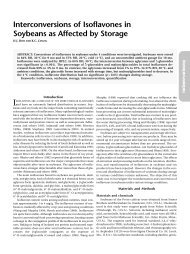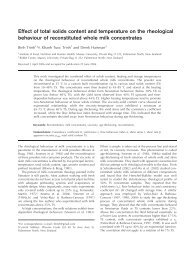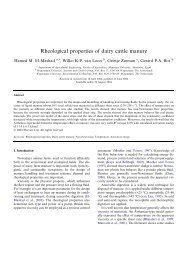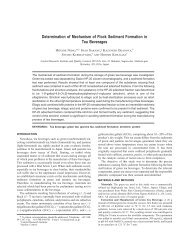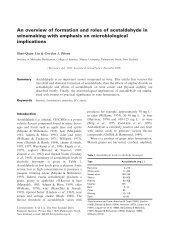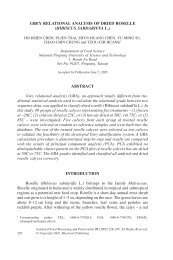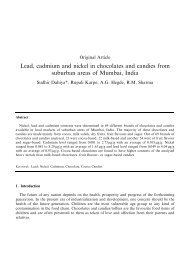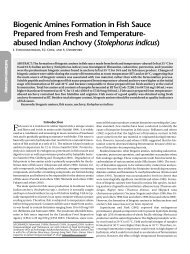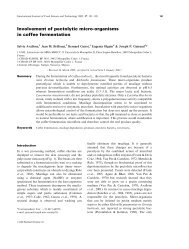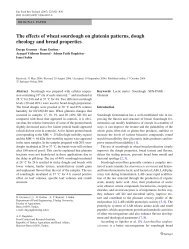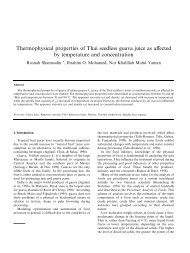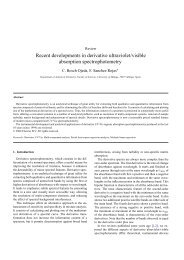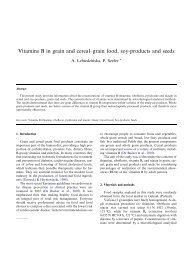FRUIT BRANDY PRODUCTION BY BATCH COLUMN ...
FRUIT BRANDY PRODUCTION BY BATCH COLUMN ...
FRUIT BRANDY PRODUCTION BY BATCH COLUMN ...
You also want an ePaper? Increase the reach of your titles
YUMPU automatically turns print PDFs into web optimized ePapers that Google loves.
Blackwell Science, LtdOxford, UKJFPEJournal of Food Process Engineering0145-8876Copyright 2005 by Food & Nutrition Press, Inc., Trumbull, Connecticut.2815367Original Article <strong>FRUIT</strong> <strong>BRANDY</strong> <strong>PRODUCTION</strong> <strong>BY</strong> REFLUX DISTIL-<br />
LATIONM.J. CLAUS and K.A. BERGLUND<br />
<strong>FRUIT</strong> <strong>BRANDY</strong> <strong>PRODUCTION</strong> <strong>BY</strong> <strong>BATCH</strong> <strong>COLUMN</strong><br />
DISTILLATION WITH REFLUX<br />
MICHAEL J. CLAUS 1,3 and KRIS A. BERGLUND 1,2,3,4,5<br />
Departments of 1 Biosystems & Agricultural Engineering, 2 Chemical Engineering &<br />
Materials Science and 3 Chemistry<br />
Michigan State University<br />
East Lansing, MI 48824<br />
4 Division of Biochemical and Chemical Process Engineering<br />
Luleå University of Technology<br />
SE-971 87 Luleå, Sweden<br />
Accepted for Publication August 12, 2004<br />
ABSTRACT<br />
The relationship between the operating parameters of batch fruit spirits<br />
column stills with reflux and the congener (trace compounds that provide<br />
flavors and aromas) concentrations in resulting fruit spirits has not been widely<br />
studied. Congener concentrations were determined in three different collection<br />
fractions, or “cuts,” during batch distillation. Acetaldehyde and ethyl acetate<br />
were found in higher concentrations in the head cut, first overhead fraction,<br />
of the distillation and have lower boiling points relative to ethanol. 1-Propanol<br />
and isoamyl alcohol (isopentanol) were present in higher concentrations in<br />
the tail cut, third or final fraction, of the distillation and have boiling points<br />
that are higher than ethanol. Methanol has a unique concentration profile as<br />
it has higher concentrations in both the head and tail cuts, but a lower<br />
concentration in the heart cut, the middle fraction which is the desired product<br />
of the distillation. Methanol was of particular interest because the distillate<br />
must adhere to governmental regulations that limit its concentration in the<br />
product. Operating-condition parameters that were studied include the number<br />
of trays used in the distillation as well as the use of a “catalytic converter,”<br />
a high surface, copper-packing material thought to catalyze formation of<br />
cyanide-containing compounds allowing them to be separated from the distillate.<br />
The effect of the number of trays used in a distillation on the concentration<br />
of ethanol and the congeners, methanol, acetaldehyde, ethyl acetate,<br />
1-propanol and isoamyl alcohol in the final distilled spirits product is presented.<br />
An additional result of acetaldehyde production at the copper surface<br />
of the catalytic converter was also discovered in the analysis of the data.<br />
5 Corresponding author. TEL: +46-920-493070; FAX: +46-920-491199; EMAIL: kris.berglund@ltu.se<br />
Journal of Food Process Engineering 28 (2005) 53–67. All Rights Reserved.<br />
© Copyright 2005, Blackwell Publishing 53
54 M.J. CLAUS and K.A. BERGLUND<br />
INTRODUCTION<br />
The two competing styles of fruit-brandy distillation are alambic – used<br />
to produce cognac, i.e., the French style and column distillation – used to<br />
produce fruit spirits, the German style. Alambic stills have no trays or appreciable<br />
reflux and require multiple distillations to achieve high-proof spirits.<br />
The distilled spirits are usually stored in wood for many years prior to bottling<br />
and sale. Column stills used to produce eau-de-vie or schnaps feature a<br />
batch still with a reflux column. A single pass through this type of still results<br />
in high proofs. These spirits are usually stored in glass and served as waterclear<br />
brandies. Typically fruit brandies, with the exception of Calvados<br />
(apple brandy) from Normandy, are produced in the German style because it<br />
tends to preserve the delicate fruit essences. In the United States the fruitspirits<br />
industry is a small but growing industry. In Michigan alone, the number<br />
of fruit-spirits stills has increased from zero in 1996 to seven in 2002.<br />
Although fruit-brandy production is well established in Europe, there are<br />
challenges to the U.S. industry that differ from its European sibling. Compounds<br />
such as methanol and urethane (ethyl carbamate) are regulated in<br />
many countries, but the regulations differ (Tanner and Brunner 1982). Methanol<br />
is currently regulated in the United States as 0.35% v/v ethanol in fruit<br />
spirits (United States Code of Federal Regulations), whereas urethane is<br />
regulated as a possible carcinogen in Canada at 400 ppb (Zimmerli and<br />
Schlatter 1991). Regulations for methanol in Europe are at higher values;<br />
therefore, methanol control has not been as much of a concern there (Tanner<br />
and Brunner 1982).<br />
It is widely known that as more trays are used in distillation, a greater<br />
separation of components is possible (Tanner and Brunner 1982; Postel and<br />
Adam 1989; Leaute 1990; Wankat 1998). However, many of these components<br />
are also positive-flavor components in the fruit spirits (Postel and Adam<br />
1989). The concentration of congeners must meet the imposed regulatory<br />
limits while at the same time offering a pleasant smelling and tasting product.<br />
Fruit-spirits production consists of four basic steps: fruit preparation<br />
(mashing), fermentation, distillation and storage (Tanner and Brunner 1982).<br />
The fruit is crushed by mechanical means using either a rolling mill or a<br />
progressing cavity pump, both of which crush the pulp of the fruit while<br />
keeping most (~ 90%) of the pits – in the case of stone fruits – from being<br />
cracked. Cracked stone-fruit pits increase the amount of urethane and benzaldehyde<br />
in the spirits because the pits contain amygdalin, a complex of cyanide,<br />
benzaldehyde and glucose (Tanner and Brunner 1982). Benzaldehyde is a<br />
positive-flavor compound, and is commonly known as bitter-almond oil, but<br />
urethane is a suspect carcinogen (Zimmerli and Schlatter 1991). The resulting<br />
mash is transported to a fermenter, where it is stirred and cooled to a temper-
<strong>FRUIT</strong> <strong>BRANDY</strong> <strong>PRODUCTION</strong> <strong>BY</strong> REFLUX DISTILLATION 55<br />
ature between 15 and 20C. Yeast is dissolved in warm water and added to the<br />
mash to begin fermentation. The fermentation is allowed to proceed for 10–<br />
15 days and the brix (% soluble solids, weight basis) is measured, until the<br />
fermentation has reached completion. The fermented mash is distilled in a<br />
batch-column still with reflux in a single operation. The distillate is collected<br />
in volumes referred to as heads (discarded first fraction), hearts (product) and<br />
tails (discarded or redistilled last fraction), and the clear spirits are stored in<br />
glass at high (> 100) proof. The spirits can be stored for as little as 3 months<br />
prior to proof adjustment with water and bottling.<br />
MATERIALS AND METHODS<br />
A schematic diagram of a typical 165 L Christian-Carl column still is<br />
shown in Fig. 1. A volume of mash between 150 and 165 L is charged to the<br />
pot of the still, which is steam jacketed. A temperature sensor at the top of<br />
the condenser is attached to a flow regulator in the condenser which adjusts<br />
condenser-water flowrate in an attempt to maintain a temperature of 72C<br />
(Plank and Plank 1998–2001). The cooling water, which is preheated through<br />
Steam<br />
inlet<br />
Steam jacket<br />
Partial condensers<br />
Total condenser<br />
Copper packing<br />
Fermented mash<br />
To<br />
drain<br />
Stirrer<br />
Bottoms<br />
removal<br />
port<br />
Tray control<br />
levers<br />
Temperature<br />
sensor<br />
Cooling water<br />
control<br />
Water<br />
inlet<br />
To drain<br />
FIG. 1. SCHEMATIC OF A 165 L CHRISTIAN-CARL STILL<br />
Distillation vapor path<br />
Cooling water path<br />
Catalytic<br />
converter<br />
Distillate<br />
discharge
56 M.J. CLAUS and K.A. BERGLUND<br />
the condenser, then passes into one of the dephlegmators, depending on the<br />
valve position. The dephlegmators are partial condensers that utilize the cooling<br />
water from the top of the main condenser, which has been partially heated<br />
by the distillate through the condenser. Usually the dephlegmator at the top<br />
of the second column is utilized. The trays are sieve trays constructed of<br />
copper equipped with a bypass that consists of a manually-operated plug. The<br />
tray-control levers, as seen in Fig. 1 control these plugs. When closed, the<br />
condensate will collect on the trays and the vapor from the lower tray must<br />
pass through the holes and therefore through the reflux condensate, causing<br />
rectification and therefore more efficient separation of the different components<br />
(Wankat 1998).<br />
The distillation was initiated by adding a 150 L charge of fruit mash into<br />
the pot of the still. Cooling water was circulated through the entire system<br />
before distillation began. The number of trays to be used was fixed as well as<br />
if the “catalytic converter” was to be engaged (this “catalytic converter,”<br />
consists of a high-surface area, copper-packing material thought to catalytically<br />
react cyanide-containing compounds with ethanol to form urethane<br />
[ethyl carbmate] and improve its separation from the product cut [Postel and<br />
Adam 1989]). Steam in the jacket of the pot was at a gauge pressure of<br />
0.3–0.4 bar and kept constant for the duration of the distillation. The still was<br />
equipped with a stirrer to keep the fruit mash from cooking at the heat-transfer<br />
surfaces in the pot portion of the still, which could result in undesired flavor<br />
compounds in the distillate, and make cleaning more difficult. The distillate<br />
was collected as three 400 mL cuts, and then as 1000 mL cuts until the alcohol<br />
concentration was below 50% alcohol by volume (A.B.V.) by hydrometer. A<br />
cut of 1000 mL was then collected as a tails cut. The tails cuts were put into<br />
a collective tails container that is saved for later redistillation. This distilled<br />
tails produces a lower-quality spirits that is adequate for blending with other<br />
higher-quality spirits or wines, but often contains too high a concentration of<br />
off flavors for consumption on their own. The total volume collected varied<br />
from run to run due to the differences in operating conditions.<br />
Fruit spirits are usually marketed between 40–45% A.B.V. (United States<br />
Code of Federal Regulations). Results are presented as the concentration of<br />
the congeners as percentage (v/v) or volume of congener per volume of<br />
ethanol in a 40% ethanol solution. Volume calculations for the ethanol produced<br />
from the distillation were based on the 40% A.B.V. concentration of<br />
ethanol.<br />
Ethyl-alcohol concentrations were measured by a tralles (% alcohol as<br />
well as proof) hydrometer with an internal thermometer for temperature corrections<br />
(Tanner and Brunner 1982). A sample from each cut was analyzed<br />
by gas chromatography. Analyses were conducted with a Shimadzu GC-17A<br />
gas chromatograph equipped with flame-ionization detection and a Stabilwax
<strong>FRUIT</strong> <strong>BRANDY</strong> <strong>PRODUCTION</strong> <strong>BY</strong> REFLUX DISTILLATION 57<br />
FIG. 2. SAMPLE CHROMATOGRAPH FROM A CHERRY EAU-DE-VIE DISTILLATION<br />
A Restek 30 m Stabilwax column with 0.25 mm i.d was used for analysis.<br />
The initial conditions had the column temperature at 40C, injector-port temperature at 240C and<br />
detector temperature of 255C.<br />
The analysis included a ramp from 40C to 190C at 2.5C/min.<br />
30 m column with an inner diameter of 0.25 mm (Restek). The initial conditions<br />
for the chromatographic analysis were column temperature at 40C,<br />
injector-port temperature of 240C and detector temperature at 255C. The<br />
temperature program used for the analyzes was a start-column temperature of<br />
40C which was ramped at 2.5C/min until a temperature of 190C was reached.<br />
The temperature was held at 190C for 5 min. A Shimadzu autosampler<br />
(AOC-20i) was used to obtain reproducibility of the 0.2 mL injection volume.<br />
Figure 2 is a sample chromatograph and Table 1 shows the relative retention<br />
times of the most common compounds in the fruit spirits, as well as their<br />
respective boiling points.<br />
RESULTS AND DISCUSSION<br />
Ethanol, methanol, acetaldehyde, ethyl acetate, isoamyl alcohol and<br />
1-propanol were chosen for monitoring because they are the compounds in<br />
highest concentrations as well as often studied for their flavor characteristics<br />
in the fruit spirits (Stinson et al. 1969a,b; Guymon 1972; Suomalainen and
58 M.J. CLAUS and K.A. BERGLUND<br />
TABLE 1.<br />
RELATIVE RETENTION TIMES FOR THE MOST COMMON COMPOUNDS IN DISTILLED<br />
<strong>FRUIT</strong> EAU-DE-VIES<br />
Chemical name Retention time (min) Boiling point (C)<br />
Acetaldehyde 2.5 20.8<br />
Acetone 3.4 56.2<br />
Ethyl formate 3.6 54.0<br />
Ethyl acetate 4.5 77.0<br />
Methanol 4.7 64.7<br />
Ethanol 5.8 78.0<br />
1-propanol 8.7 97.0<br />
Isopentanol (isoamyl alcohol) 16.3 132.0<br />
Benzaldehyde 33.0 179.0<br />
Source: Plank and Plank 1998–2001.<br />
Lehtonen 1979; Postel and Adam 1989). The first set of experiments explored<br />
the effect of the number of trays on the ethanol concentration in the resulting<br />
product. The second set of experiments explored how the number of trays<br />
affected the concentration of congeners in the product. Sampling of the spirits<br />
occurred at the time of distillation and the samples were run on the GC-FID<br />
within 36 h of collection.<br />
Two fermentations of Stanley plums, which were frozen for six months<br />
and thawed prior to fermentation, were studied for the effects of ethanol<br />
concentration as the number of trays were changed. Also the effect of the<br />
catalytic converter was studied for its effect on the ethanol concentration.<br />
These spirits are usually bottled in 375-mL bottles and the results are presented<br />
in total volume of 40% ethanol as well as number of 375-mL bottles<br />
of 40% ethanol. Each distillation contained the same volume of mash from<br />
the fermentation. Overhead product was collected with 1200 mL of heads (in<br />
three 400 mL volumes) and volumes of 1000 mL of hearts until a concentration<br />
of
Ethanol conc. (% v/v)<br />
90<br />
80<br />
70<br />
60<br />
50<br />
<strong>FRUIT</strong> <strong>BRANDY</strong> <strong>PRODUCTION</strong> <strong>BY</strong> REFLUX DISTILLATION 59<br />
0 2000 4000 6000 8000<br />
Cumulative distillate volume (mL)<br />
1 2 3 4<br />
FIG. 3. THE AVERAGE CONCENTRATION OF ETHANOL (% V/V) WITH VARYING<br />
DISTILLATION CONDITIONS<br />
(1) All three trays used and catalytic converter engaged. (2) All three trays used with no catalytic<br />
converter. (3) Two trays used with catalytic converter engaged and (4) Two trays used with no catalytic<br />
converter. A single fermentation of plum mash was divided into four distillations for these results.<br />
Operating conditions<br />
0 5 10 15 20 25 30<br />
Number of 40% A.B.V. bottles<br />
1 2 3 4<br />
FIG. 4. TRANSLATION OF THE DATA IN FIG. 3 INTO BOTTLES OF 40% ETHANOL, PLUM<br />
<strong>BRANDY</strong> AT THE FOUR DIFFERENT OPERATING CONDITIONS<br />
(1) All three trays used and catalytic converter engaged. (2) All three trays used with no catalytic<br />
converter. (3) Two trays used with catalytic converter engaged and (4) Two trays used with no<br />
catalytic converter.
60 M.J. CLAUS and K.A. BERGLUND<br />
Acetaldehyde concn.<br />
(% v/v)<br />
0.9<br />
0.6<br />
0.3<br />
0<br />
0 2100 4200 6300<br />
Cumulative distillate volume (mL)<br />
1 2 3 4<br />
FIG. 5. ACETALDEHYDE PROFILE: CONCENTRATION OF ACETALDEHYDE IN CHERRY<br />
DISTILLATES AS A FUNCTION OF CUMULATIVE VOLUME OF DISTILLATE AT FOUR<br />
DIFFERENT OPERATING CONDITIONS<br />
(1) All three trays used and catalytic converter engaged. (2) All three trays used with no catalytic<br />
converter. (3) Two trays used with catalytic converter engaged and (4) Two trays used with no catalytic<br />
converter. A single cherry fermentation divided into four distillations to obtain these results.<br />
harvest and thawed prior to mashing and fermentation were used. The congeners<br />
studied were acetaldehyde and ethyl acetate (low-boilers); methanol<br />
because of its regulation; and 1-propanol and isoamyl alcohol (high-boilers).<br />
These components are the five congeners present in the highest concentration.<br />
Acetaldehyde is the main component emerging before methanol in the<br />
distillation of cherry spirits. It has a distinctive aroma characteristic, which<br />
can cause an eau-de-vie to have a poor aromatic characteristic when present<br />
in too high concentration (Stinson et al. 1969a). As acetaldehyde has a low<br />
boiling point, its largest concentration is distilled into the heads portion of the<br />
distillate. However, when fewer trays are used, a larger concentration proceeds<br />
into the hearts portion of the distillate. Acetaldehyde is completely soluble in<br />
both water and ethanol; therefore, it is not easily separated from the spirits.<br />
A plot of the acetaldehyde profile can be found in Fig. 5. After acetaldehyde,<br />
ethyl acetate is the most abundant of the minor components of cherry distillates<br />
boiling before methanol (Stinson et al. 1969a). Ethyl acetate has a similar<br />
profile to that of acetaldehyde, as can be seen in Fig. 6.<br />
Methanol is a health hazard that is regulated in the U.S.A. at 0.35%<br />
(v/v) in distilled spirits (United States Code of Federal Regulations). The<br />
amount of methanol produced in the hearts was just above this level. The<br />
methanol profile exists such that the methanol concentration is higher in
Ethyl acetate concn. (% v/v)<br />
0.5<br />
0.4<br />
0.3<br />
0.2<br />
0.1<br />
0<br />
<strong>FRUIT</strong> <strong>BRANDY</strong> <strong>PRODUCTION</strong> <strong>BY</strong> REFLUX DISTILLATION 61<br />
0 2100 4200 6300<br />
Cumulative distillate volume (mL)<br />
1 2 3 4<br />
FIG. 6. ETHYL ACETATE PROFILE: THE CONCENTRATION OF ETHYL ACETATE IN<br />
CHERRY DISTILLATES AS A FUNCTION OF CUMULATIVE VOLUME OF DISTILLATE<br />
UNDER FOUR DIFFERENT OPERATING CONDITIONS<br />
(1) All three trays used and catalytic converter engaged. (2) All three trays used with no catalytic<br />
converter. (3) Two trays used with catalytic converter engaged and (4) Two trays used with no catalytic<br />
converter. A single cherry fermentation divided into four distillations to obtain these results.<br />
the heads, drops in the hearts to a lower concentration, and then increases<br />
again in the tails. Of the compounds examined, methanol has a unique distillation<br />
profile. Figure 7 shows the methanol-concentration curves per cumulative<br />
distillation volume for the operating conditions used. The distillation<br />
profile of methanol in this type of multistage-batch distillation is different<br />
than it would be for an alambic-style distillation (Suomalainen and Lehtonen<br />
1979). It is important to test each cut to minimize the methanol concentration<br />
in the hearts cut. Methanol is considered by many to be a positive-flavor<br />
constituent in distilled spirits. It is difficult to separate the methanol from the<br />
ethanol-water mixture further without loss of many of the other flavor components<br />
from the distillate. The concentration must be below 0.35% (v/v) but<br />
it is desirable to have the concentration close to regulatory limit, as it is a<br />
positive-flavor component.<br />
Fusel alcohols compose the largest group of aroma compounds in alcoholic<br />
beverages (Stinson et al. 1969b). Isoamyl alcohol (3-methyl-1-butanol)<br />
is the main fusel alcohol synthesized during fermentation by yeast. 1-Propanol<br />
is considered as another important fusel alcohol, as it is the simplest alcohol<br />
larger than ethanol (Stinson et al. 1969b; Suomalainen and Lehtonen 1979).
62 M.J. CLAUS and K.A. BERGLUND<br />
Methanol concn. (% v/v)<br />
0.55<br />
0.45<br />
0.35<br />
0.25<br />
0 2100 4200 6300<br />
Cumulative distillate volume (mL)<br />
1 2 3 4<br />
FIG. 7. THE CONCENTRATION OF METHANOL IN CHERRY DISTILLATES AS<br />
A FUNCTION OF CUMULATIVE VOLUME OF DISTILLATE UNDER DIFFERENT<br />
DISTILLATION CONDITIONS<br />
(1) All three trays used and catalytic converter engaged. (2) All three trays used with no catalytic<br />
converter. (3) Two trays used with catalytic converter engaged and (4) Two trays used with no catalytic<br />
converter. A single cherry fermentation divided into four distillations to obtain these results.<br />
However, these two compounds distill earlier than most of the other fusel<br />
alcohols and therefore they are considered to be early indicators of the balance<br />
of the remaining fusel alcohols. The fusel alcohols produce a “damp cloth”<br />
aroma that is undesirable in the production of spirits. 1-Propanol and isoamyl<br />
alcohol are present in the hearts in small quantities, and increase in concentration<br />
at the end of the hearts cut and begin to decrease in the tails. Most<br />
fusel alcohols will be present in greater concentrations in the tails than in the<br />
hearts. Measuring the presence of 1-propanol or isoamyl alcohol on line would<br />
allow for an easier determination of where to make the hearts/tails cut. A plot<br />
of the concentration of isoamyl alcohol and 1-propanol per distillation volume<br />
can be seen in Figs. 8 and 9, respectively.<br />
Figure 10 shows the concentration of acetaldehyde, ethyl acetate, methanol,<br />
1-propanol and isoamyl alcohol as they would exist when the distillate<br />
was diluted to 40% ethanol. A higher number of trays produced a lower<br />
concentration of acetaldehyde in the distillate, although the catalytic converter<br />
seemed to increase the amount of acetaldehyde in the hearts of the distillate.<br />
The isoamyl alcohol shows the effect of the trays on the congeners with<br />
boiling points greater than ethanol. The more trays that were used resulted in<br />
a reduced concentration of congener. This is useful for controlling the fusel<br />
alcohols as they have an undesired aroma characteristic.
Isoamyl alcohol concn.<br />
(% v/v)<br />
0.24<br />
0.16<br />
0.08<br />
<strong>FRUIT</strong> <strong>BRANDY</strong> <strong>PRODUCTION</strong> <strong>BY</strong> REFLUX DISTILLATION 63<br />
0<br />
0 2100 4200 6300<br />
Cumulative distillate volume (mL)<br />
1 2 3 4<br />
FIG. 8. ISOAMYL ALCOHOL CONCENTRATION IN CHERRY DISTILLATES AS A<br />
FUNCTION OF CUMULATIVE VOLUME OF DISTILLATE UNDER FOUR DIFFERENT<br />
DISTILLATION CONDITIONS<br />
(1) All three trays used and catalytic converter engaged. (2) All three trays used with no catalytic<br />
converter. (3) Two trays used with catalytic converter engaged and (4) Two trays used with no catalytic<br />
converter. A single cherry fermentation divided into four distillations to obtain these results.<br />
1-Propanol concn. (% v/v)<br />
0.35<br />
0.25<br />
0.15<br />
0.05<br />
0 2100 4200 6300<br />
Cumulative distillate volume (mL)<br />
1 2 3 4<br />
FIG. 9. 1-PROPANOL CONCENTRATION IN CHERRY DISTILLATES AS A FUNCTION OF<br />
CUMULATIVE VOLUME OF DISTILLATE WITH DIFFERENT OPERATING CONDITION<br />
(1) All three trays used and catalytic converter engaged. (2) All three trays used with no catalytic<br />
converter. (3) Two trays used with catalytic converter engaged and (4) Two trays used with no catalytic<br />
converter. A single cherry fermentation divided into four distillations to obtain these results.
64 M.J. CLAUS and K.A. BERGLUND<br />
Congener concn. (% v/v)<br />
0.4<br />
0.3<br />
0.2<br />
0.1<br />
0<br />
Acetaldehyde Ethyl acetate Methanol 1-propanol Isoamyl alcohol<br />
Congener<br />
1 2 3 4<br />
FIG. 10. CONGENER CONCENTRATION IN DRINKING STRENGTH EAU-DE-VEUX (40%<br />
ETHANOL v/v) PRODUCED <strong>BY</strong> BLENDING AND DILUTION OF HEART CUTS<br />
(1) All three trays used and catalytic converter engaged. (2) All three trays used with no catalytic<br />
converter. (3) Two trays used with catalytic converter engaged and (4) Two trays used with no catalytic<br />
converter. A single cherry fermentation divided into four distillations to obtain these results.<br />
Overall most compounds with a higher boiling point (than ethanol) will<br />
have a profile that contains smaller concentrations of congener in the heads<br />
and early hearts and then the concentration will increase in the latter hearts<br />
and tails. The compounds that have lower boiling points (than ethanol) tend<br />
to have higher concentrations in the heads and early hearts and the concentration<br />
steadily decreases throughout the distillation process. Methanol has a<br />
distillation profile different from most of the other congeners. Methanol tends<br />
to have a higher concentration in the heads and tails than it does in the hearts.<br />
Because in these fruit spirits the concentration of methanol is so close to the<br />
regulatory limit of 0.35% v/v one must be careful as to where to take one’s<br />
cuts.<br />
The presence of the catalytic converter affected the amount of the congeners<br />
in the distillate. One explanation for the concentration differences in<br />
runs with this device from those without it is that the device acts as an<br />
additional tray. However, upon inspection, the copper packing in the device<br />
was visibly corroded after three of four distillations. The corroding material<br />
is probably a mixture of congeners that have condensed on the copper surface<br />
and adhered to the copper surface over time. The surface can be cleaned with<br />
a dilute citric acid solution, but the effectiveness of the device will need to be<br />
further studied.
<strong>FRUIT</strong> <strong>BRANDY</strong> <strong>PRODUCTION</strong> <strong>BY</strong> REFLUX DISTILLATION 65<br />
TABLE 2.<br />
ACETALDEHYDE CONCENTRATIONS PRESENT IN A DISTILLATION OF 5% ETHANOL<br />
UNDER TWO DIFFERENT DISTILLATION CONDITIONS, WITH CATALYTIC CONVERTER<br />
AND WITH THE CATALYTIC CONVERTER <strong>BY</strong>PASSED<br />
Cumulative volume (mL) Acetaldehyde concentration (% v/v)<br />
No catalytic converter Catalytic converter used<br />
500 None detected None detected<br />
1000 None detected 0.00287<br />
1500 None detected 0.00216<br />
2500 None detected 0.00390<br />
3500 None detected 0.00263<br />
4500 None detected 0.00307<br />
5500 None detected 0.00310<br />
6500 None detected 0.00216<br />
A further look at the acetaldehyde profile in Fig. 5 reveals a slight<br />
increase in acetaldehyde concentration in the latter parts of the distillation<br />
when the catalytic converter was engaged. The formation of acetaldehyde on<br />
the copper surface as a dehydrogenation product from ethanol was postulated.<br />
Dai and Gellman have demonstrated the formation of acetaldehyde on copper<br />
surfaces during the heating of alcohols (Dai and Gellman 1993). A distillation<br />
of a pure 5% ethanol solution with both the catalytic converter engaged, and<br />
bypassed, was conducted to see if the acetaldehyde were being produced from<br />
the ethanol, or another source in the fermentation. The chromatography of the<br />
cuts taken resulted in peaks for ethanol and acetaldehyde when the catalytic<br />
converter was engaged, and only a peak for ethanol when the catalytic converter<br />
was bypassed. The acetaldehyde concentrations can be seen in Table 2,<br />
with the resulting distillate volume for each cut taken.<br />
CONCLUSION<br />
The concentration profiles for ethanol, methanol, acetaldehyde, ethyl<br />
acetate, 1-propanol and isoamyl alcohol were measured for different operating<br />
conditions in fruit-spirits distillation. Methanol was shown to have a unique<br />
distillation profile that did not simply track boiling point as is generally the<br />
case for other congeners. Use of all the trays increased the concentration of<br />
the ethanol while decreasing the concentration of the congeners in the product.<br />
The catalytic converter was shown to act as an additional tray for the
66 M.J. CLAUS and K.A. BERGLUND<br />
distillation process; however, the catalytic converter promoted formation of<br />
acetaldehyde during the distillation procedure.<br />
ACKNOWLEDGMENTS<br />
The authors wish to thank the financial support of Project Generating<br />
Research and Extension to meet Environmental and Economic Needs<br />
(GREEEN) from the Michigan Department of Agriculture and the Michigan<br />
Agricultural Experiment Station. In addition, the United States Department of<br />
Agriculture, the Cherry Marketing Institute and Michigan Horticultural<br />
Society are thanked for their support.<br />
REFERENCES<br />
DAI, Q. and GELLMAN, A.J. 1993. Fluorine substitutent effects on alkoxide<br />
chemistry and orientation on the Cu(100) surface. J. Phys. Chem. 97,<br />
10,783–10,789.<br />
GUYMON, J.F. 1972. Higher alcohols in beverage brandy: Feasibility of<br />
control of levels. Wines Vines 53, 37–40.<br />
LEAUTE, R. 1990. Distillation in alambic. Am. J. Enol. Viticult. 41, 90–103.<br />
PLANK, A. and PLANK, C. 1998–2001. Göppingen, Germany, Personal<br />
Correspondence with Authors.<br />
POSTEL, W. and ADAM, L. 1989. Fruit distillate flavours. In Distilled<br />
Beverage Flavour: Recent Developments (J.R. Piggott and A. Patterson,<br />
eds.) pp. 133–147, Ellis Horwood Ltd., Cambridge.<br />
STINSON, E.E., STINSON, E.E., DOOLEY, C.J., FILIPIC, V.J. and HILLS,<br />
C.H. 1969a. Composition of montmorency cherry essence: 1. Low-boiling<br />
components. J. Food Sci. 34, 246–248.<br />
STINSON, E.E., STINSON, E.E., DOOLEY, C.J., FILIPIC, V.J. and HILLS,<br />
C.H. 1969b. Composition of montmorency cherry essence: 2. Highboiling<br />
components. J. Food Sci. 34, 544–546.<br />
SUOMALAINEN, H. and LEHTONEN, M. 1979. The production of aroma<br />
compounds by yeast. J. Inst. Brew. 85, 149–156.<br />
TANNER, H. and BRUNNER, H.R. 1982. Fruit Distillation Today, 3rd Ed.<br />
(English Translation), Heller Chemical and Administration Society,<br />
Germany.<br />
United States Code of Federal Regulations. Standards of identity for distilled<br />
spirits. In Title 27 – Alcohol, Tobacco Products and Firearms, Chapter<br />
I, Part 5, Subpart C. Taken from website. http://www.access.gpo.gov/<br />
nara/cfr/cfr-table-search.html (accessed May 24, 2001).
<strong>FRUIT</strong> <strong>BRANDY</strong> <strong>PRODUCTION</strong> <strong>BY</strong> REFLUX DISTILLATION 67<br />
WANKAT, P.C. 1998. Equilibrium Staged Separations, pp. 87–367, Prentice<br />
Hall, NJ.<br />
ZIMMERLI, B., and SCHLATTER, J. 1991. Ethyl carbamate: Analytical<br />
methodology, occurrence, formation, biologic activity, and risk assesment.<br />
Mutat. Res. 259, 325–350.



